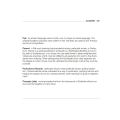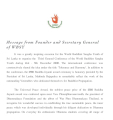Buddhist teachings : ค้นหาหนังสือธรรมะ หน้า 7 / 18
หน้าหนังสือทั้งหมด

127
The Practice of Ānāpānasmṛti: Breath Meditation in Early Buddhism
describing the practice of the four smrtyṣhānas associated with the breath (ānāpānasmṛti), and resulting the attainment of the three vimoksamukhās.42
An Shigao’s translation of the Ānāpānasmṛti Sūtra
This text delves into the practice of Ānāpānasmṛti, a significant Buddhist meditation focused on breath. It highlights An Shigao’s translation of the Ānāpānasmṛti Sūtra and its influence on later monk

163
Understanding Pali and Parami in Buddhism
Pali: an ancient language used in India, now no longer an active language. The original Buddhist scriptures were written in Pali. Pali texts are used by the Theravada school of Buddhism.
Parami: a Pa
…r of virtue necessary for all practitioners on their path to enlightenment. For more information on Buddhist teachings, visit dmc.tv.

5
Luang Por Dattajevo: A Visionary in Thai Buddhism
Luang Por Dattajevo (monastic name Phrabhavanaviriyakhun) is a Thai Buddhist monk who was born in 1941, in Kanchanaburi, Thailand. He was educated within the public school system of Thailand and went
Luang Por Dattajevo, born in 1941 in Kanchanaburi, is a notable Thai Buddhist monk and educator. After receiving a post-graduate degree in Australia, he helped establish Wat Phra Dhammakaya in 1970 an

20
The Origins and Impact of the Dhammakaya Foundation
The Dhammakaya Foundation itself was established on 20 February 1970. Buildings were kept to a minimum and emphasized finesse, easy maintenance, cleanliness and durability. The foundation stone for th
The Dhammakaya Foundation was established on 20 February 1970 with a focus on minimalistic yet durable structures for spiritual practice. H.R.H. Princess Maha Chakri Sirindhorn provided the foundation

5
Understanding Kamma and Buddhist Practices
The event begins after Buddhist Lent and continues for one month.
กรรม kamma; karma; action; deed; willed action; an intentional action that has future consequences, including future reboots; th
…) to the Sakyans (ภะยัสดงศคาย), reflects the rich tapestry of beliefs and rituals that characterize Buddhist teachings, deepening the connection between our actions and the cycles of life.

54
The Story of Culasubhadda
4
The Story of Culasubhadda
While residing at the Jetavana monastery, the Buddha uttered Verse (5) of this chapter, with reference to Culasubhadda the daughter of Anathapindika.
Anathapindika and U
The story revolves around Culasubhadda, the daughter of Anathapindika, who faced challenges in her marriage due to her parents-in-law's non-Buddhist beliefs. Living in the house of Ugga's family, she

3
Establishment of Rules in the Pāṭimokkha
Abstract:
When Were the Rules in the Pāṭimokkha Established?
by THANAVUDDHO BHIKKHU
Many modern scholars in both the East and West share the view that most of the content in the Vinayapitaka, t
This article by THANAVUDDHO BHIKKHU discusses the establishment of monastic rules in the Pāṭimokkha, challenging the view that these rules were developed post-Buddha. Through comparative studies of va

61
The Pali Language and the Theravadin Tradition
NORMAN, K.R.
1983 “The Pali Language and the Theravadin Tradition.”
A History of Indian Literature: 1-2, edited by Jan Gonda. Wiesbaden: Otto Harrassowitz.
PEW Research Center.
2017 “World Bu
This text discusses the significance of the Pali language within the Theravadin Buddhist tradition. It examines its historical roots, literary contributions, and the ongoing impact on Buddhist practic

48
DMC และ Buddhist TV ลงนาม MOU อย่างเป็นทางการ
DMC
The Only One Channel
Official MOU Sign
between
Dhammakaya Media Channel
&
The Buddhist TV Chann
on Wes
29 ten
20
Buddhist TV คือ สถานีโทรทัศน์ที่มาพร้อม
สโลแกน "The Buddhist Peace of Mind to All”
Buddhist TV คือสถานีโทรทัศน์ที่มีสโลแกน 'ความสงบสุขทางใจสำหรับทุกคน' เปิดให้บริการตั้งแต่ปี 2550 ในภาษาสิงหล อังกฤษ และทมิฬ โดยมีการออกอากาศ 24 ชั่วโมง พร้อมข่าวดีว่า Buddhist TV จะมอบเวลาออกอากาศให้

50
คุณยายวัย 94 ปี เดินทางไปกราบธรรมทูตจากวัดพระธรรมกาย
DMG
Octo
คุณยายท่านหนึ่ง อายุ ๙๔ ปี หลังจากได้ดูรายการถ่ายทอดสดก็รู้สึกปลื้มปีติจนทนอยู่บ้านไม่ไหว
ต้องออกเดินทางจากบ้านตั้งแต่ตี 4 ของวันรุ่งขึ้น พาลูกหลานอีก ๔๐ ชีวิต มาถึงสถานี Buddhist
TV เพื่อจะม
เรื่องราวของคุณยายวัย 94 ปี ที่รู้สึกปลื้มปีติหลังได้ชมรายการถ่ายทอดสด จึงตัดสินใจเดินทางไปยังสถานี Buddhist TV พร้อมลูกหลานเพื่อกราบก๊วนธรรมทูตจากวัดพระธรรมกาย ถึงแม้จะมีระยะทางถึง 6 ชั่วโมง แต่ความต

188
Message from the Founder and Secretary General of WBSY
Message from Founder and Secretary General of WBSY
It was a greatly inspiring occasion for the World Buddhist Sangha Youth of Sri Lanka to organize the Third General Conference of the World Buddhist
The World Buddhist Sangha Youth of Sri Lanka organized their Third General Conference from 2nd - 5th December 2006, themed 'Tolerance and Harmony'. The event included the 2550 Buddha Jayanti award cer

101
Understanding the Pāli Verses and Buddhist Doctrine
The Text
The first nine leaves are inscribed with Pāli verses and a commentary in Tai Yuan.4 The final leaf of the manuscript is an addendum, inscribed with a stanza of the Dvatiṃsa-mahāpuruśa-lakkhaṇ
The manuscript presents Pāli verses and commentary in Tai Yuan, summarizing Buddhist doctrines about the Buddha's physical body and wisdom. It includes thirty stanzas highlighting qualities like divin

138
Exploring Chinese Philosophical Texts and Their Influence
Kohn, Livia, and Yoshinobu Sakade. Taoist Meditation and Longevity Techniques. Center for Chinese Studies, University of Michigan, 1989.
Mair, Victor H. “What Is Geyi, After All?” In Philosophy and Re
This collection examines various texts that shed light on the development of Chinese philosophical thought and literary traditions. Works range from Livia Kohn's exploration of Taoist meditation pract

251
หลักฐานธรรมในคัมภีร์พระธรรม
หลักฐานธรรมในคัมภีร์พระธรรมนั้น 1 ฉบับประชาชน
Harrison, Paul M. 1990. The Samādhi of direct encounter with the Buddhas of the present: an annotated English translation of the Tibetan version of the P
เนื้อหานี้นำเสนอการสำรวจหลักฐานธรรมในคัมภีร์พระธรรมโดยการอ้างอิงงานศึกษาที่สำคัญเกี่ยวกับ Dhamma-kāya และความสัมพันธ์ระหว่างมันกับการบรรลุ enlightenment งานที่สำคัญเช่น เพื่อบันทึกการพัฒนาและการประยุก

559
Buddhist Literature and Manuscripts
Bailey, H. W. 1979. *Dictionary of Khotan Saka*. Cambridge: Cambridge University Press.
Banerjee, Anukul Chandra. 1979. *Sarvästivāda literature*. Calcutta: The World Press Private Limited.
Batchelor,
This collection features important works and studies related to Buddhist literature and manuscripts, covering a range of topics including the Khotan Saka dictionary, Sarvästivāda literature, and the s

154
Buddhist Texts and Translation Studies
Chen Hui Zhuan 陳慧攢, and The SAT Daizōkyō Text Database. “Yin Chi Ru Jing Zhu 陰持入經註 T1694.” Tripitaka. Tokyo, November 28, 2011. The SAT Daizōkyō Text Database.
Deleanu, Florin. 1997. “A Preliminary S
This compilation includes various studies and translations relevant to Buddhist texts, focusing on significant works such as 'Yin Chi Ru Jing Zhu' and 'Wu Men Chan Jing Yao Yongfa'. Scholars like Chen

50
Computerization of the Buddhist Pali Canon
The text in the image reads:
"The Computerization of the Buddhist Pali Canon
With the recognition that many world scholars have been impeded from fully studying the Buddhist scriptures by inconvenie
The Computerization of the Buddhist Pali Canon began in 1984 by the Dhammakaya Foundation to improve access for scholars worldwide. Utilizing the Romanized Pali Canon Text, the project produced a data

125
Understanding Key Buddhist Concepts
"Fools" (palay): spiritually defective people. A fool is someone wicked, weak, or feeble in a moral sense. His discretion is faulty, not knowing right from wrong, good from bad. A fool is one who give
This content delves into various Buddhist concepts such as 'fools'—spiritually defective individuals whose actions reflect moral weakness. It explains that heaven in Buddhism comprises six levels prov

30
Vinayapitaka Editions and References
Vinayapitaka vol.IV. 2001. edited by Hermann Oldenberg. Oxford:
PTS. (first printed. 1882)
Vinayapitaka vol.V. 2006. edited by Hermann Oldenberg. Oxford:
PTS. (first printed. 1883)
อ้างอิงอื่น ๆ
PT
Vinayapitaka editions include volumes IV and V, edited by Hermann Oldenberg, published by the Pali Text Society with first prints in 1882 and 1883 respectively. Other important references include Nori

6
Exploring Early Buddhist Schools: Pāli and Chinese Connections
considered to have already appeared in the early Buddhist schools (Hinayāna) period at the latest and to have been widely recognized by at least two schools in company of them.
Throughout a study of t
This study examines the connections between Pāli and Chinese stanzas through early Buddhist schools, specifically focusing on: (1) Two Pāli stanzas aiding the understanding of Chinese transliterated t
